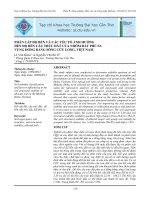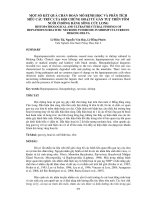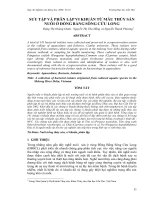Hội chứng hoại tử gan tụy cấp tính (AHPNS) trên tôm nuôi ở Đồng bằng sông Cửu Long, Việt Nam potx
Bạn đang xem bản rút gọn của tài liệu. Xem và tải ngay bản đầy đủ của tài liệu tại đây (91.43 KB, 2 trang )
Hội chứng hoại tử gan tụy cấp tính (AHPNS)
trên tôm nuôi ở Đồng bằng sông Cửu Long,
Việt Nam
Hội chứng hoại tử gan tụy cấp tính (AHPNS), còn gọi là hội chứng tôm chết sớm
(EMS), lần đầu tiên xuất hiện ở các trang trại nuôi tôm ở các tỉnh ven biển Đồng
bằng Sông Cửu Long trong năm 2010. Dịch bệnh vẫn tiếp tục bùng phát trong năm
2011 và 2012, gây thiệt hại nghiêm trọng chủ yếu ở các ao nuôi thâm canh và bán
thâm canh và lây lan sang một số tỉnh ven biển phía Bắc. Bệnh xảy ra quanh năm,
nhưng nghiêm trọng nhấ
t là từ tháng 4 đến tháng 7, ảnh hưởng đến ao nuôi tôm sú
(Penaeus monodon) và tôm thẻ chân trắng Thái Bình Dương (Penaeus vannamei).
Tỉ lệ nhiễm AHPNS thường cao hơn trong mùa khô khi độ mặn và nhiệt độ cao.
Kết quả kiểm tra thông số môi trường cho thấy chất lượng nước không phải là
nguyên nhân chính của AHPNS. Dư lượng thuốc bảo vệ thực vật (deltamethrin,
fenitrothion) đã được phát hiện trong cả ao bị ảnh hưởng và không bị ảnh hưởng
bởi dị
ch bệnh, tuy nhiên, nghiên cứu thực nghiệm đánh giá ảnh hưởng của thuốc
trừ sâu (deltamethrin) cho thấy nồng độ gây chết rất thấp (từ 0,001 μg/L đến 0,1
μg/L), và không phát hiện dấu hiệu của AHPNS điển hình trong gan tụy của tôm
khi tiếp xúc với thuốc trừ sâu. Chủng vi khuẩn Vibrio phổ biến nhất được tìm thấy
trong máu của tôm từ hầu hết các ao bị nhiễm bệnh là V. parahaemolyticus, nhưng
điề
u trị bằng thuốc kháng sinh (oxytetracycline, florfenicol) không hiệu quả. Thí
nghiệm gây cảm nhiễm trong điều kiện phòng thí nghiệm bằng các phương pháp
ngâm tôm postlarvae khỏe trong dịch chiết xuất từ gan tụy tôm nhiễm AHPNS
trong 14 ngày; tiêm vào cơ tôm bằng dịch chiết từ gan tụy tôm nhiễm AHPNS
được lọc qua màng 0,22 và 0,45 μm; và cho tôm ăn cả phần đầu tôm hoặc chỉ gan
tụy tôm nhiễm AHPNS đều không phát hiện tổn thương của gan tụy giống với cấu
trúc gan tụy quan sát trong các ao nuôi thương phẩm nhiễm AHPNS. Nghiên cứu
cảm nhiễm với vi khuẩn V. parahaemolyticus nhiễm thể thực khuẩn (phage) trong
ao nuôi đang được tiến hành.
Acute hepatopancreatic necrosis syndrome (AHPNS), also called early mortality
syndrome (EMS), first appeared on shrimp farms in the coastal provinces of the
Mekong Delta in 2010. It continued to occur in 2011 and 2012, causing serious
mortality mainly in intensive and semi-intensive farms and spreading to some
northern coastal provinces. The disease occurs throughout the year, but it’s most
severe from April to July, affecting ponds stocked with wild black tiger shrimp
(Penaeus monodon) and domesticated Pacific white shrimp (Penaeus vannamei.
Incidences of AHPNS seem to be higher during the dry season when salinities and
temperatures are higher. Results of environmental parameter tests showed that
water quality is not the main cause of AHPNS. Pesticide residues (deltamethrin,
fenitrothion) were detected in both affected and unaffected ponds. However,
experimental studies evaluating the effects of the most commonly used pesticide
(deltamethrin) showed lethality at very low concentrations (from 0.001 μg/L to 0.1
μg/L), but no signs of typical AHPNS in the hepatopancreas (HP) of exposed
shrimp. The most common Vibrio bacteria found in the HP of shrimp from most
infected ponds was V. parahaemolyticus, but treatment with antibiotics
(oxytetracycline, florfenicol) was not effective. Challenge experiments in
laboratory conditions by either immersion of healthy shrimp postlarvae in the
extracted HP of AHPNS shrimp for 14 days, muscular injection of 0.22 and 0.45
μm filtered extracted HP inoculums and feeding with either whole head or HP of
AHPNS shrimp could not induce lesions of the HP consistent with the disease
observed in growout ponds. Infectivity studies with V. parahaemolyticus carrying
phage and cohabitation experiments in culture ponds are in progress.
© Triệu Thanh Tuấn, www.aquanetviet.org
.
Nguồn: The Thumb Drive Containing the Abstracts from Aquaculture 2013
(February 21-25, 2013, Nashville, Tennessee, USA). Dang Thi Hoang Oanh, Tran
Viet Tien, Truong Quoc Phu and Nguyen Thanh Phuong. Acute Hepatopancreatic
Necrosis Syndrome (AHPNS) on Farmed Shrimp in The Mekong Delta, Vietnam.
February 2013.









